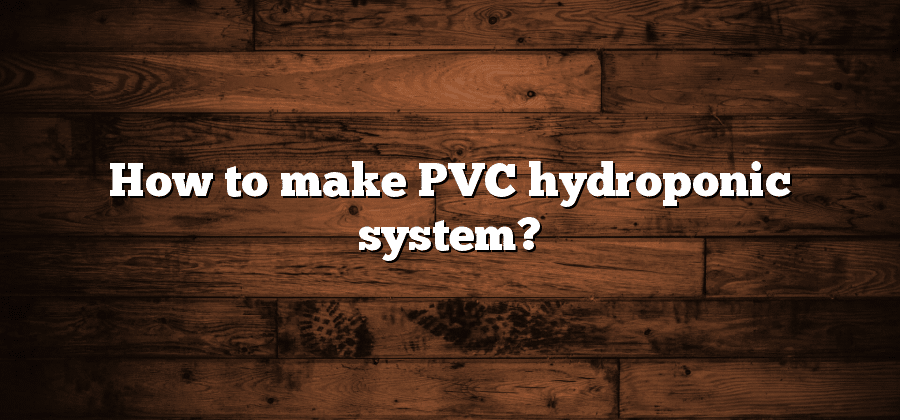Selecting the appropriate PVC materials
When it comes to selecting the appropriate PVC materials for your hydroponic system, it is important to consider a few key factors. First and foremost, you will want to ensure that the PVC pipes and fittings you choose are made from high-quality, durable materials. This will ensure that your system can withstand the constant flow of water and nutrient solutions without any leaks or breakdowns.
Additionally, it is crucial to select PVC materials that are chemically resistant. Since hydroponic systems involve the use of nutrient solutions, it is essential to avoid any materials that may leach harmful chemicals into the water. Look for PVC pipes and fittings that are specifically designed for use in irrigation systems to ensure they are safe for both your plants and the environment.
Furthermore, consider the size and dimensions of the PVC materials needed for your hydroponic system. Depending on the scale of your project, you may require different diameters and lengths of pipes. Take into account the space available for your system and the number of plants you plan to grow to determine the appropriate sizing for your PVC materials.
In conclusion, selecting the appropriate PVC materials for your hydroponic system is a critical step in ensuring its success and longevity. By choosing high-quality, chemically resistant materials in the correct size and dimensions, you can create a robust and efficient system that will support the growth of healthy plants.
Assembling the PVC frame for the hydroponic system
To assemble the PVC frame for your hydroponic system, begin by gathering all the necessary materials and tools. You will need PVC pipes, connectors, a tape measure, a saw, and PVC cement. It is important to select the appropriate materials for your specific needs, ensuring they are durable and able to withstand the moisture and weight of the hydroponic setup.
Start by measuring and cutting the PVC pipes to the desired lengths for your frame. Use a saw to make clean, straight cuts. Next, apply PVC cement to the ends of the pipes and insert them into the connectors, ensuring a secure fit. Repeat this process until you have assembled the desired frame structure.
Once the frame is assembled, double-check all connections and make any necessary adjustments. It is crucial to ensure the frame is sturdy and level to support the weight of the hydroponic system. Once you are satisfied with the assembly, you can move on to preparing the nutrient solution for your hydroponic cultivation.
Preparing the nutrient solution for hydroponic cultivation
To achieve successful hydroponic cultivation, preparing the nutrient solution is a crucial step. This solution serves as the primary source of nutrition for the plants, replacing the need for traditional soil. It is essential to carefully select and balance the appropriate elements in the nutrient solution to ensure optimal plant growth and development.
When preparing the nutrient solution, it is important to consider the specific needs of the plants you are growing. Different plant species require different levels of nutrients, so it is necessary to research and understand the specific nutrient requirements for each type of plant. Additionally, maintaining the correct pH level is crucial for nutrient absorption, as it affects the availability of different elements. Regular monitoring and adjustment of the nutrient solution are necessary to ensure that the plants receive the proper nutrition they need for healthy growth and abundant yields.
Installing the water pump and irrigation system
Water Pump Installation:
Once you have assembled the PVC frame and prepared the nutrient solution for your hydroponic system, the next step is to install the water pump and irrigation system. This crucial component will ensure a steady flow of water and nutrients to your plants, promoting their growth and health.
Start by selecting a water pump that suits the size and needs of your hydroponic setup. Consider factors such as flow rate, power consumption, and noise level when making your choice. Once you have your pump, carefully follow the manufacturer’s instructions to install it. Generally, this involves connecting the pump to a water source, such as a reservoir or storage tank, and ensuring that the water flow is directed through the irrigation system properly. Take your time to set up the system correctly, as any errors can lead to poor water circulation and negatively affect your plants.
Creating the growing containers for the plants
To ensure the success of your hydroponic system, it is crucial to create the appropriate growing containers for your plants. These containers are essentially where your plants will thrive and receive the necessary nutrients. When selecting the containers, there are a few factors to consider.
Firstly, the size of the containers should be appropriate for the type of plants you are growing. Different plants have varying root structures and growth patterns, so having containers that accommodate their needs is essential. Additionally, the material of the containers should be durable and non-toxic, as it will come in contact with the nutrient solution. PVC pipes or food-grade plastic containers are often popular choices due to their affordability and ease of maintenance.
Once you have chosen the containers, make sure they have drainage holes at the bottom to prevent waterlogging and promote oxygen circulation. This is crucial as excessive water can lead to root rot and hinder plant growth. Additionally, placing the containers on elevated surfaces can further enhance drainage and prevent water retention. By carefully selecting and preparing the growing containers, you are setting the foundation for healthy and productive plants in your hydroponic system.






